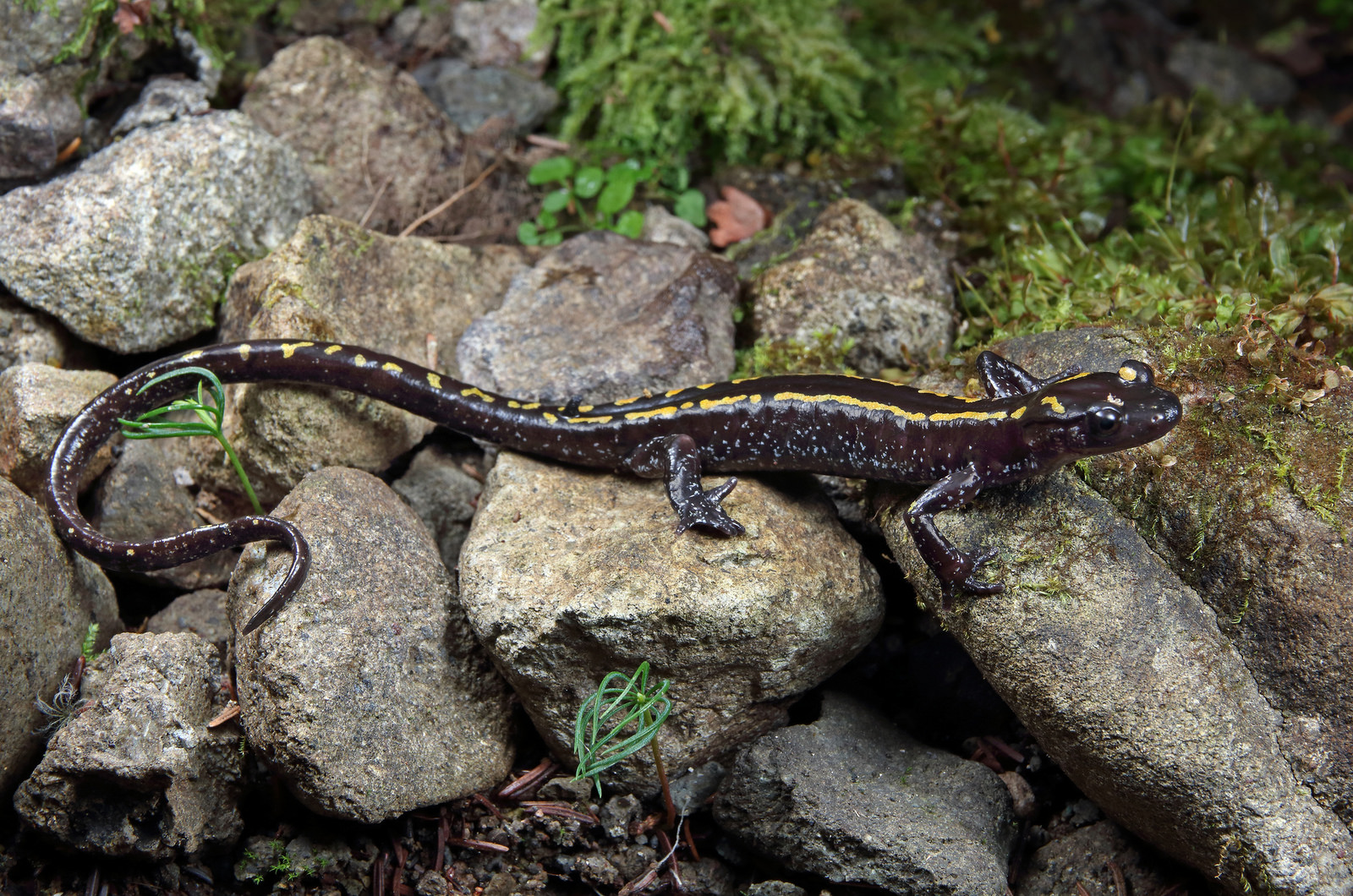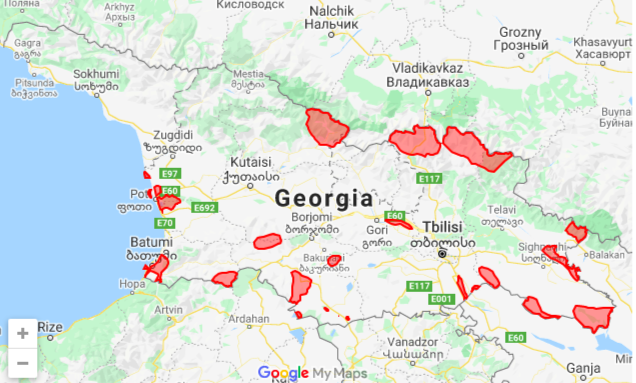Browse by taxonomy
Simple search by name
Mertensiella caucasica
Taxon: Mertensiella caucasicaAuthor: Laura and Bobby Bok
Comment: Borjomi-Kharagauli National Park, adult ♂
Uploaded by: Armen_Seropian

Download full size image 1600 X 1060
Name According To: http://research.amnh.org/herpetology/amphibia/
Species: caucasica
Taxon Rank: Species
Scientific Name Authorship: Waga, 1870
Vernacular Name: Caucasian Salamander
Georgian Name: კავკასიური სალამანდრა
GBD Remarks:
Relic species, endemic of SW Caucasus. Subspecies M. c. janashvilii (Tartarashvili & Bakradze, 1989) at Mt. Mtirala near Batumi and probably along the Black Sea coast. Comosed of two evolutionary species, M. sp. 1 in the basin of Mtkvari (Kura) river and M. sp. 2 in the basin of Black Sea, non-recognisable morphologically (Tarkhnishvili et al., 2000). Closest relative: golden-striped salamander (Chioglossa lusitanica) from the NW Iberian peninsula. Separation from the sister taxon ca. 15 MY (Veith et al., 1997). Palaeonthological species M. cf. caucasica, Polish Carpathians, lower Pliocene (Sanchiz & Mlinarsky, 1978).
Stream-dwelling salamander of midde size, with a thin elongated body. Strictly nocturnal. Female deposits 10-25 relatively large eggs in hidden places in water or outside water in humid areas. Larval development lasts one to three years.
Conservation Status (International): IUCN status (international) VU, B2ab(ii,iii) ver 3.1. Definition (Area of occupancy estimated to be less than 2000 km2, and the area of occupancy is severely fragmented and continuing decline inferred for the area of occupancy and extent or area or quality of habitats). Relict narrow-ranged species.
Conservation Status (national): Georgian Red List. IUCN National status (2007) VU (B1+2c): (Extent of occurrence estimated to be less than 20,000 km2, and area of occupancy estimated to be less than 2000 km2, and extreme fluctuation of the number of locations). Georgia covers over 25% of the world-wide range of the species, and completely covers the range of the eastern evolutionary lineage, with millions of years of independent evolutionary history. Included in the list of key animal species, National Biodiversity Strategy and Action Plan for Georgia (2005)
Economic importance (national): Currently absent. Potentially interesting as an attraction of herp-tourists and scientists.
Is it not a flagship species important from the point of view of local population.
Who conducts currently field research of this species in Georgia: Ilia State University, Institute of Ecology, Institute of Zoology. contact – David Tarkhnishvili.
Ongoing projects: Currently, no ongoing projects. Monitoring of representative set of selected known populations would include seven field-days for two trained students per year.
Specific relevant information: Range size: best-known from the model of Tarkhnishvili et al. (2008) – The observed extent of occurrence of the eastern lineage is c. 1,000 km2 and predictedrange is 1,782 km2. The observed extent of occurrence of the western lineage lies largely in Turkey. Detailed action plan for conservation is available in paper of Tarkhnishvili & Kaya, 2009 that can be downloaded from http://assets.panda.org/downloads/cepf_caucasus_web_1.pdf
Relevant website: http://assets.panda.org/downloads/cepf_caucasus_web_1.pdf; http://nacres.org/amph02.html
Why to monitor: Rare endemic salamander important for conservation. Good indicator of quality of mountain brook ecosystem. However, it is not considered as a species important for conservation by local population. Economically unimportant.
Preliminary suggestion: Insert existent data (Range model, known locations) in a general easily accessible database for protected species of Georgia. Organise biannual monitorig of presence-absence salamanders at ten locations evenly distributed throughout Georgian range. Requires ca. 7 field days every two years for an expert and a student to conduct.
რელიქტური სახეობა, დასავლეთ მცირე კავკასიონის ენდემი. ქვესახეობა M. c. janashvilii (Tartarashvili & Bakradze, 1989) აღწერილია მტირალას მთიდან. შესდგება ორი ევოლუციური სახეობისაგან, M. sp. 1 მდინარე მტკვრის აუზიდან და M. sp. 2 შავი ზღვის აუზიდან; მორფოლოგიურად ისინი ვერ გაირჩევიან (Tarkhnishvili et al., 2000). უახლოესი ნათესავი: ოქროსზოლიანი სალამანდრა (Chioglossa lusitanica) ჩრდილოეთ ესპანეთიდან და პორტუგალიიდან. ეს ორი ტაქსონი ერთმანეთს გამოეყო დაახლ. 15 მილიონი წლის წინათ (Veith et al., 1997). პალეონტოლოგიური სახეობა, M. cf. caucasica, ნაპოვნია პოლონეთის კარპატების ქვედა პლიოცენში (Sanchiz & Mlinarsky, 1978). საშუალო ზომის სალამანდრაა, მოგრძო, ვიწრო სხეულით და ძალზე გრძელი კუდით. ბინადრობს წყაროებთან და ნაკადულებთან. ღამის ცხოველია. მდედრი ამაგრებს 10-20 ღია ფერის კვერცხს დიამეტრით 5 მმ-მდე თითო წყლის ზედაპირთან ან წყალთან, მალულ ტენიან ადგილებში. ლარვები 3 წლამდე წყალში ცხოვრობენ.
კონსერვაციული სტატუსი (საერთაშორისო): IUCN სტატუსიVU, B2ab(ii,iii) ver 3.1. განმარტება (შეფასებული გავრცელების არე 20,000 კმ2- ზე ნაკლებია და დაკავებული ფართი ფრაგმენტირებულია და დაკავებული ფართი მცირედება და ეცემა ჰაბიტატების ხარისხი). რელიქტური მცირე არეალის მქონე სახეობაა.
კონსერვაციული სტატუსი (ეროვნული): საქართველოს წითელი ნუსხა. IUCN ეროვნული სტატუსი (2006) VU (B1+2c): ((შეფასებული გავრცელების არე 20,000 კმ2- ზე ნაკლებია და დაკავებული ფართი 2000 km2 - ზე ნაკლებია და ჰაბიტატების რიცხვის უკიდურესი ფლუქტუაციები). საქართველოში განლაგებულია ამ სახეობის არეალის 25%-ზე მეტი და აღმოსავლეთი ევოლუციური ხაზის (რომლის დამოუკიდებელი ევოილუცია მილიონობით წელი გრძელდებოდა) არეალი მთლიანად საქართველოშია განლაგებული. შეტანილია საკვანძო სახეობების ნუსხაში, საქართველოს ბიომრავალფეროვნების სტრატეგია და მოქმედებათა გეგმა (2005)
ეკონომიკური მნიშვნელობა (ეროვნული): ამჯამად არ არსებობს. პოტენციალურად საინტერესო სახეობაა ბუნების მოყვარულ ტურისტებისთვის და მეცნიერებისთვის.
კონტაქტი/ მიმდინარე პროექტები: ილიას სახელმწიფო უნივერსიტეტი, ეკოლოგიის ინსტიტუტი, ზოოლოგიის ინსტიტუტი. საკონტაქტო პირი - დავით თარხნიშვილი. ამჯამად არ იკვლევა. შესაძლებელია რჩეული ჰაბიტატების მონიტორინგი (10 ლოკალიტეტამდე) ორ წელიწადში ერთხელ.
რელევანტური ინფორმაცია: არეალის ზომა: Tarkhnishvili et al. (2008) მოდელი აჩვენებსდაახლ 1,000 km2 გავრცელების არეს და 1,782 km2 პოტენციურად სასარგებლო ფართობს აღმოსავლურ ევოლუციურ ხაზისათვის. დეტალური საკონსერვაციო მოქმედების გეგმა (Tarkhnishvili & Kaya, 2009) მისაწვდომია მისამართზე http://assets.panda.org/downloads/cepf_caucasus_web_1.pdf.
რელევანტური საიტი: http://assets.panda.org/downloads/cepf_caucasus_web_1.pdf
რატომაა საჭირო მონიტორინგი: იშვიათი ენდემური ცხოველია. მთის წყაროების მდგომარეობის კარგი ინდიკატორი.
რეკომენდაცია: არსებული ინფორმაცია ჰაბიტატების შესახებ შეტანილ იქნას მისაწვდომ მონაცემთა ბაზაში, გაკეთდეს 10 ჰაბიტატის მონიტორინგი ორ წელიწადში ერთხელ. მონიტორინგს ადვილად განახორციელებს ორი დატრენინგებული სტუდენტი 7 დღის განმავლობაში.
Page Authors: David Tarkhnishvili ,
Reference of occurrence in Georgia: D. Tarkhnishvili & R. Gokhelashvili, 1999. The Amphibians of the Caucasus. Pensoft, Sofia.
Conservation Status
This section is under construction
National Red List Status of have not been evaluated

